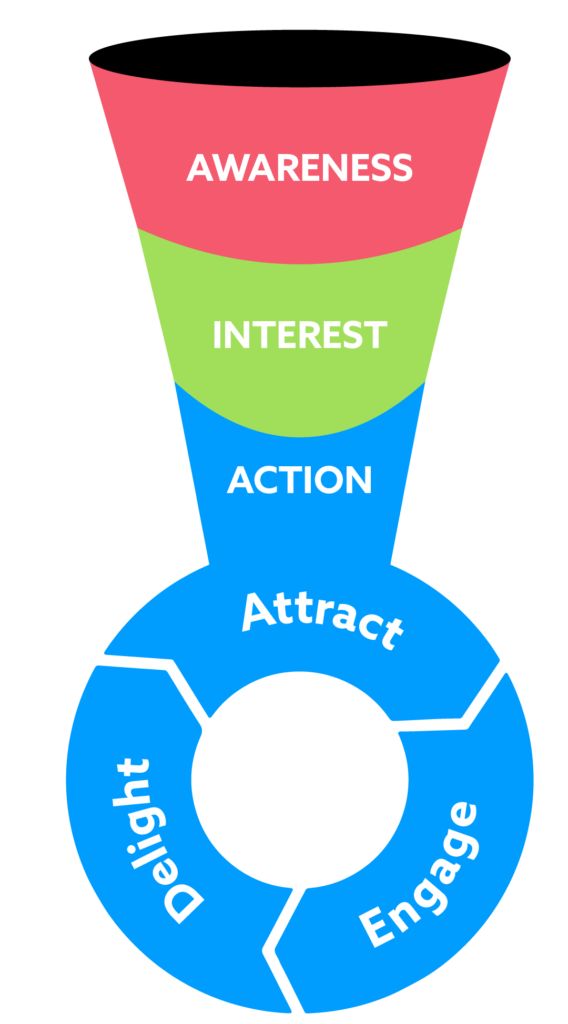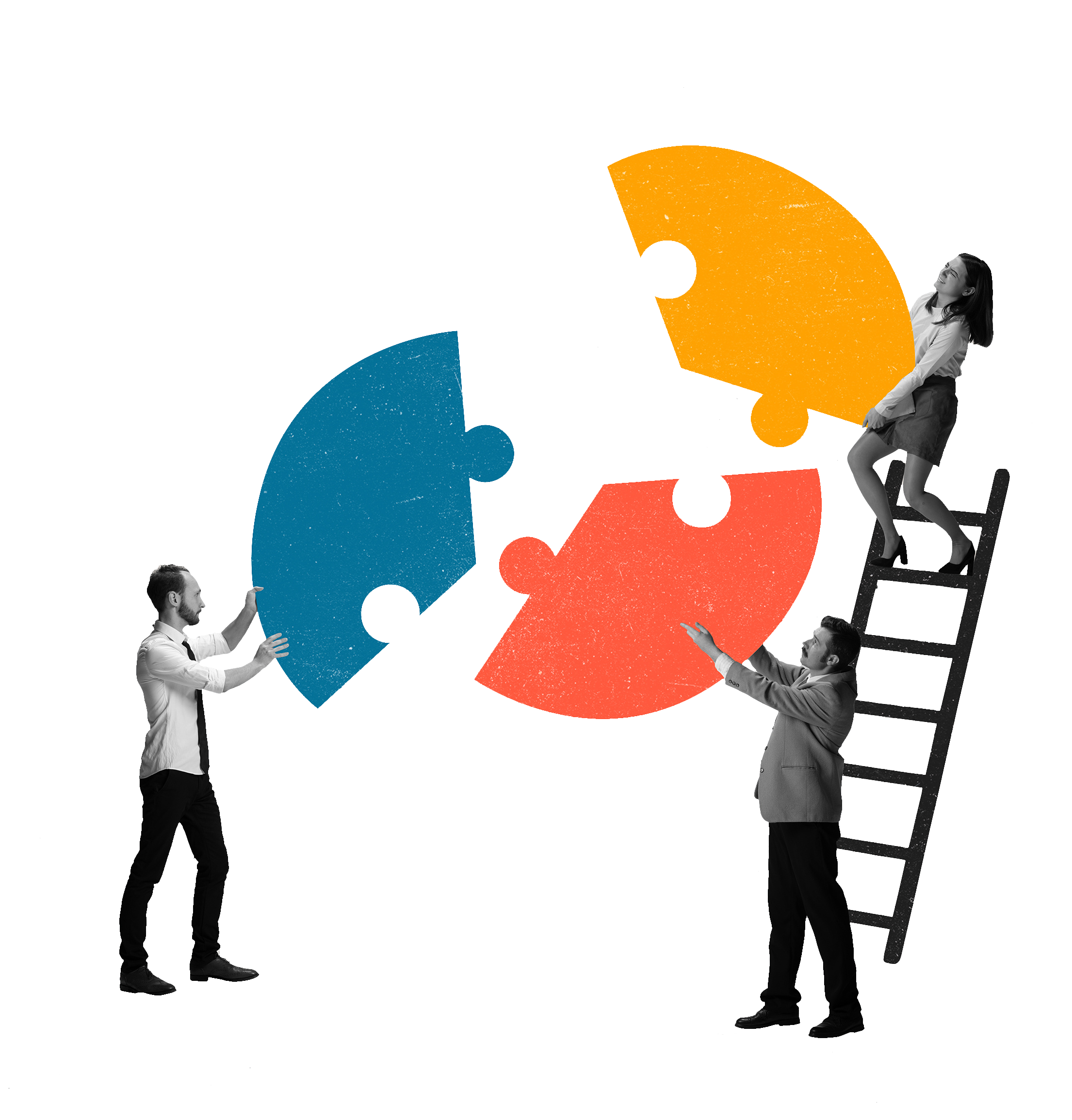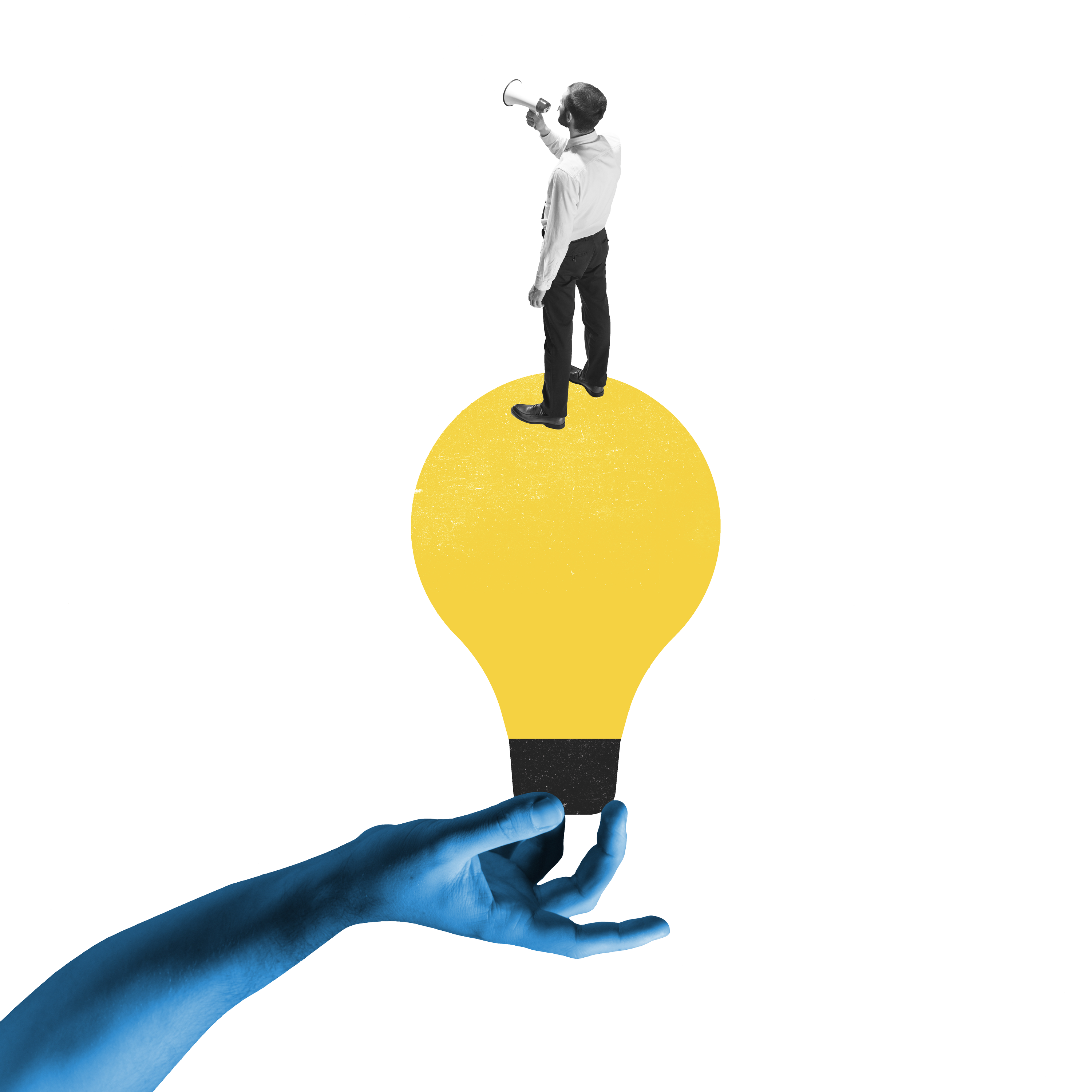Marketing Funnel vs Flywheel: Can You Have It All?
Like Soylent Green, businesses are people. However, unlike the staple meal in a dystopian future, you have to build relationships to sell to businesses. And while there’s an art to building relationships, at Logical we primarily concern ourselves with how relationship-building translates to digital. There’s plenty of science available to support building a well-planned strategy executed to maximize returns as efficiently as possible.
Enter the FlyFunnel.
Here at Logical, we decided to end the debate on whether we should follow the hallowed Funnel (raise awareness, consideration, and purchases) versus blaze new trails with the Flywheel (attract, engage delight). Our answer is that we should do both. And our strategy works because we think about — and therefore treat — “leads” like people.
What Is B2B Marketing?
Some podcasters and pundits would have you believe that B2B marketing is a wholly different beast compared to consumer-facing strategies. Such “thought leaders” tout that selling to businesses requires a certain savviness, lots of jargon, and a whole lot of fancy digital badges from reputable sources.
While those are all nice things to have, they really don’t have much to do with strategy. They are tactics intended to impress others. So what’s the right strategy? I’d sum it up by saying it’s exactly the same as how you’d go about inviting someone over for dinner.
Think about it. Often the primary focus of any B2B digital marketing initiative is to generate leads. This makes sense as a KPI, but B2B marketers need to think much bigger than just that. Form fields are spun gold, but — and it’s a big “but” — we often forget another word for “leads” is “people.” And so a paradigm-shifting, knock-your-socks-off B2B strategy starts with a seemingly humble introduction.
Before asking someone over for dinner, you express sincere interest in them and share a bit about yourself. If you start with, “WOW! LOOK AT ALL THESE G2 BADGES I HAVE!!! YOU SHOULD GIVE ME YOUR INFORMATION BECAUSE I’M CLEVER!” folks are going to be put off. If you start with, “Hey, I noticed you’re struggling to manage these widgets. Gosh, we struggled with that too awhile back, and it’s not that hard for us anymore. Wanna see what we figured out?” You can humble-brag about your G2 badges or name drop Forbes later, but not when you first meet folks on the digital sidewalk.
You make the introduction, you create a solid first impression, and you’re a few steps away from having them over for dinner. Once they’re ready to come over, serve up a decent meal and — sometimes it takes more than one Boeuf Bourguignon — they’re eventually ready to do business.
Meet FlyFunnel
You need to serve a great meal to keep folks at the table, don’t you? It’s as much about presentation as it is about nourishment. And so I hope you see where I’m going. The Funnel Gospel is all about the introduction, asking folks over for dinner. The Flywheel is all about serving fantastic food, leading spectacular conversation, and eventually setting a date for your next dinner party.
The Funnel is a spectacular tool for organizing marketing strategy. When I build an advertising plan, I select channels and build out campaigns to leverage audience targeting, messaging, content, and creative to directly connect with people who need to hear what I have to say. I say the same thing over and over with themes and variations — keep asking them to dinner — until they say, “Sure, why the hell not?” I keep them aware of what I have to offer, give them reasons to consider, and let them know where we are should they ever want to break bread.

The key difference with the Flywheel is that I keep them coming back for more.
Life happens, and so I empathize when a time doesn’t work because something came up. I ask about their dietary restrictions. I let them know what I plan to prepare for them when they are able to come over. And when they do finally drop by, I do everything I can to help them have the time of their life.
Here at Logical, we like the FlyFunnel marketing strategy because it covers the full customer journey, not just your typical funnel marketing strategy lead-gen pipeline. We spend equal time, care, and attention crafting the introduction, invitation, and celebration of relationship-building.
We do this for two reasons:
- it only seems logical that “leads” would like to be treated like people, and,
- it works.
Why Logical Wants To Make the FlyFunnel Happen
The Marketing Funnel has been around for a long time, and so there’s some merit to that. Originally created by Elias St. Elmo Lewis back in the 1800s, the model was a great way to organize marketing strategies when professional advertising was still a fairly young concept.
To this day, through the progression from attention to interest to desire to action, it just makes so much sense. And it’s a super useful tool. Again, when I’m pitching a client on a marketing campaign, I account for top, middle, and bottom of funnel tactics. Having some way to organize myself (and have accountability) is extremely helpful.
But a 100+-year-old model can only get you so far, and it’s fun to embrace “shiny,” new things. As Marketing Mag boldly claimed back in 2018, “The funnel is dead.”
While the Funnel focuses on a linear process with a clear end, the Flywheel model is cyclical, it suggests with more energy you build momentum, creating a virtuous cycle that grows profit over time. (On a personal note, I think of this as the fidget-spinner model.) I don’t just want new customers, I want to ensure that I remain attractive to the customers I have, engage them in great conversation, and delight them with Michelin Star-worthy food.
But — and I will continue to milk these two extended metaphors — if the Funnel ends, the Flywheel loses momentum. Connect them and one feeds the other. The gravity that pulls “leads” in fuels the mechanism that keeps them and existing “customers” in orbit for businesses, keeping them around for sale, renewal, and upsell.
Going back to the dinner analogy, I can keep the party going if more people keep coming over with more food and even better stuff to talk about. And what’s awesome about this model is that folks can leave and come back. I want to send people home feeling delighted so I know they’ll eventually return, ideally with their plus-ones or a crew of others.

What FlyFunnel Looks Like for B2B Marketing
FlyFunnel works for B2B marketing because it centers strategy on building AND maintaining relationships with prospective customers. To successfully do this, marketers have to look beyond a single platform and think about what people actually want and where they’re going to go to find it. By plotting our course by mapping out the customer journey, we’re able to figure out how to connect with and continuously engage prospects.
In practice, Logical starts this process with client onboarding. We get really nosy and ask a bunch of questions to identify
- Why is a client paying us to do their marketing?
- What does our client have to offer?
- Who are they looking for?
- How are their competitors and similar businesses going about things (and where do they have a leg up on us)?
- Where can we reach the people we’re looking for?
Answering those questions lays the foundation for everything we do. Having this rough schematic also gives us an opportunity to offer a new perspective as a strategic partner. We take qualitative data (messaging, value props, testimonials, and reviews) and combine that with quantitative data (search volume, reach, engagement). We then leverage the two to build a thoughtful, tailored plan for early success.
This process helps us identify how we can be both accountable and strategic. Sure, everyone wants more high-quality lead volume. But we ask: What’s the right blend of Paid versus SEO versus email marketing tactics to get where we need to be? What does stability look like? How can we keep growing and innovating together?
And this last bit is where the real magic happens. Our first 90 days with a client are all about building the infrastructure for connecting with the right person at the right time to nudge them toward the right decision. But we’re honestly building blind. We know what generally works, but we don’t necessarily know what works best for a client’s unique context. And so we have to build everything the right way to first have it and then be in a position to flip levers, pull knobs, and cycle new parts in-and-out as needed.
Our philosophy is that we build, fuel, and refine our B2B relationship engine cyclically over time, and we have to remain responsive to changes in environment as well as innovations along the way.
FlyFunnel Finale
B2B marketing is about building relationships, and the best way to do that is to invite folks over for dinner. The FlyFunnel model does just that. The Funnel outlines how to introduce ourselves by being seen, talked to, and connected with. The Flywheel focuses on how, after introductions, interested folks can give us an opportunity to engage and delight them over a well-planned meal. One paradigm fuels the other, and by developing holistic marketing strategies that account for the full customer journey, we are able to establish virtuous cycles that go beyond ads, channels, and tactics to generate exponentially greater returns over time.
And so I gotta ask: Would you be interested in coming over for dinner some time? I’d love to share more about what we’re doing here at Logical.
Talk to an expert about your marketing needs








